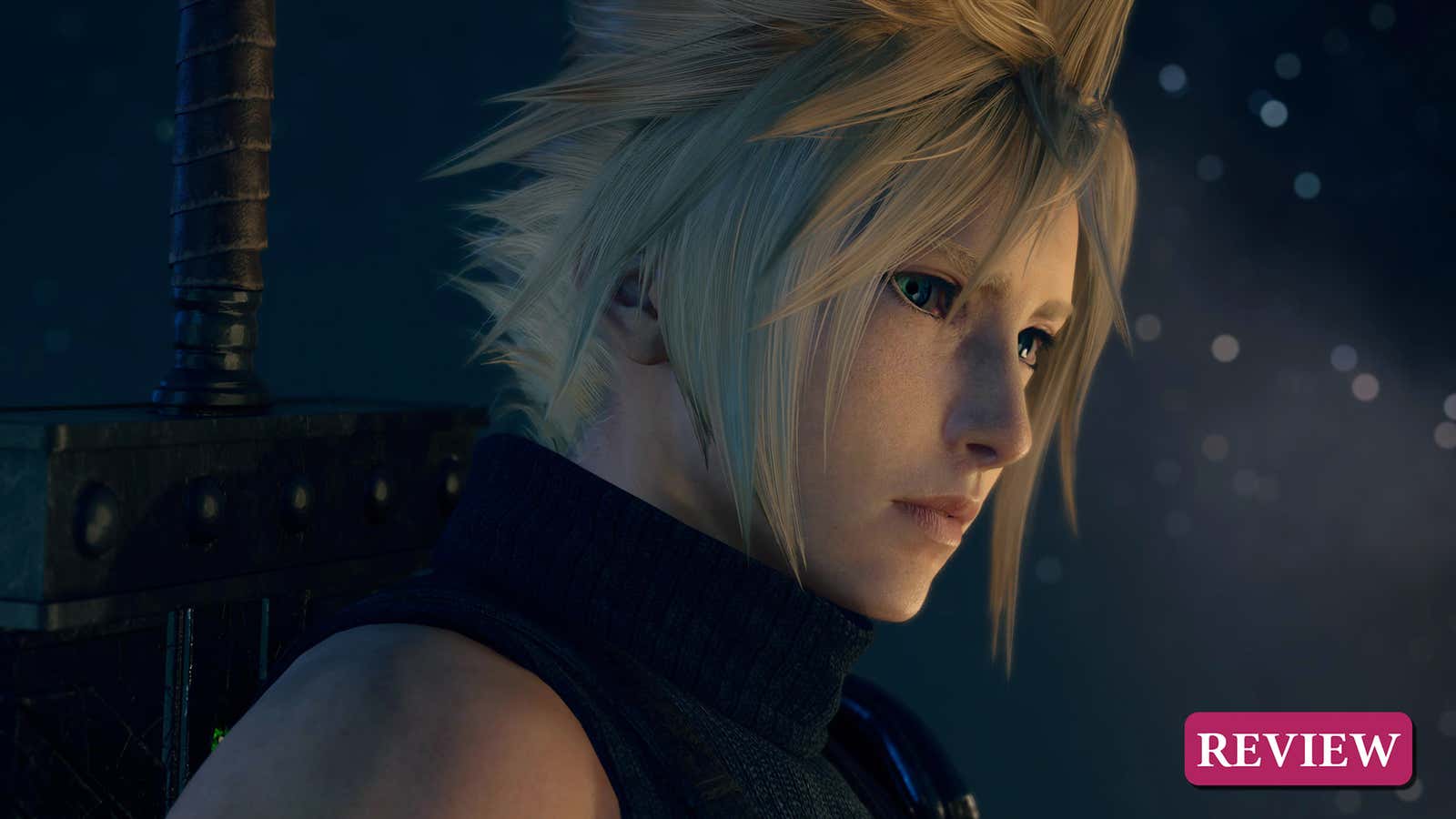Having fled a polluted city of unchecked corporate, militaristic oppression, I’m hit with the light of a bright blue, endless sky. Rich green grass extends endlessly before me; mountains tower in the distance. The world around me is a wellspring of life. Yet it’s haunted by a creeping shadow of harm. I see it in the people whose towns I visit, their lives marred by a history of a violence. I see it in the mindless, wandering robed remnants of a grotesque military campaign to scientifically produce a perfect soldier. This is a world of beauty and loss. And I fear it’s in its last days.
Along with a group of people who I’ve come to rely on, I continue to push forward into this strange and unexpected world, haunted by the call of something I do not understand. As I travel further, things don’t turn out the way I expected…the way I remember them. I see visions of things that look familiar, but then they shift into something different. Am I who I think I am? Is this the world I thought I knew? Moving through this place is a practice in memory, reinterpretation, and perseverance.
Read More: Final Fantasy VII Rebirth’s First Three Chapters Rocked My Socks Off
Pre-order Final Fantasy VII Rebirth: Amazon | Best Buy | Target
Final Fantasy VII Rebirth, available on PlayStation 5 on February 29, 2024, is the second installment of one of the most anticipated games in recent memory: a remake of what is considered by many to be the greatest game of all time, 1997’s Final Fantasy VII.
Rebirth also follows 2020’s Final Fantasy VII Remake, widely regarded as a successful recreation of the first section of the original game, and one whose foundational changes to the original story are as equally perilous as they are fascinating.
Read More: Everything You Need To know About Final Fantasy VII, Before Rebirth
Rebirth continues in the same vein. Seemingly a story about a story that’s already happened in some other dimension or point in time and space, Rebirth aspires to be the most indulgent version of a beloved game. And as it covers pivotal moments in the original narrative, this second installment is a key hit-or-miss moment for the trilogy. After Remake’s surprising twists and turns, Rebirth takes on the burden of proving whether or not the ambitious endeavor to remake one of the greatest games of all time was worth it.
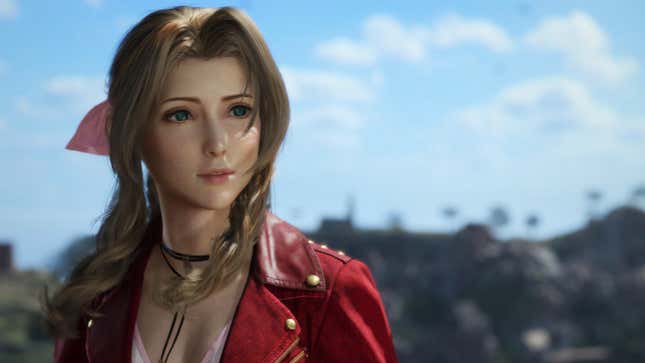
While this story is sure to be discussed, debated, celebrated, and criticized for years to come, this is also a colossal fantasy RPG that can entertain you for weeks—and which you should space out if you don’t want to exhaust yourself. In my time playing Rebirth before release, I found a game that could make me laugh and cry. It would send me adrift in a sea of nostalgia, but also test my patience more often than I liked. Overall, Rebirth is a stunningly large and expansive RPG that I was more than happy to sink my time into to unravel its winding narrative, spec out my characters for battle, and ruminate on all that FF7 has meant to me for nearly three decades.
An open world as expansive as the original (and full of busywork)
When I first stepped out into the Grasslands region of Rebirth, I wasn’t hit with a map with tons of little objectives (yet). It’s just the world before me, in the spirit of the original, with places of interest I can check out, and roaming expansiveness that often bears a close aesthetic similarity to the original.
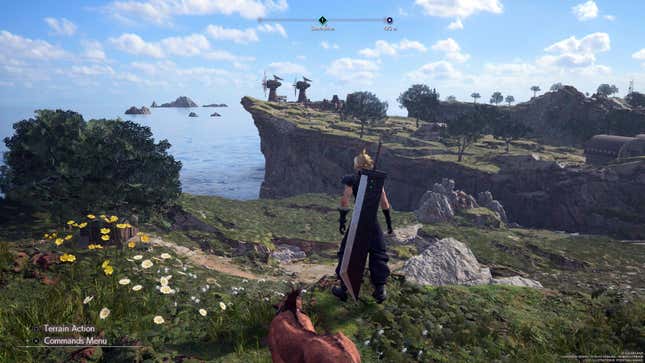
Sadly, that expansiveness somewhat shrinks once you run into the very chatty Chadley, the AI cyborg who returns from Remake to help you develop materia to cast magic spells and summon god-like beings while inviting you to try out combat challenges. This time around, Chadley also wants you to gather “World Intel” by scanning crystals, climbing towers, fighting monsters, and sourcing unique objects. You know, it’s not like you have a world-ending crisis to stop or anything.
Read More: I’m Convinced FF7 Rebirth Is A Sequel To The 1997 Original
I did not mind the open-world activities. I finished nearly all of them. It wasn’t exactly mindblowing stuff, but the company I kept and the aesthetic beauty of the world made even the dullest stretches largely inoffensive. Nearly all of these activities are done alongside the iconic FF7 Party™: Aerith, Tifa, Yuffie, Barret, and Red XIII at your side. Oh, and Cait Sith is here. Unlike the original game, your characters visibly follow you out in the world, and the ones not in your combat lineup are visible on the sidelines of battle, sometimes even offering a helping hand to the action.
As you explore the world, some gamey activities make their presence known to you rather seamlessly. Scanning lifestream springs, for example, is often prompted by an owl that will fly close to you and hoot to grab your attention to that activity. Another one sees a baby chocobo chick run up to you, urging you to follow and unlock a new fast travel point. These moments are pleasant to come across and make the world feel reactive to my presence, though it bordered on repetitive over the course of tens and tens of hours.
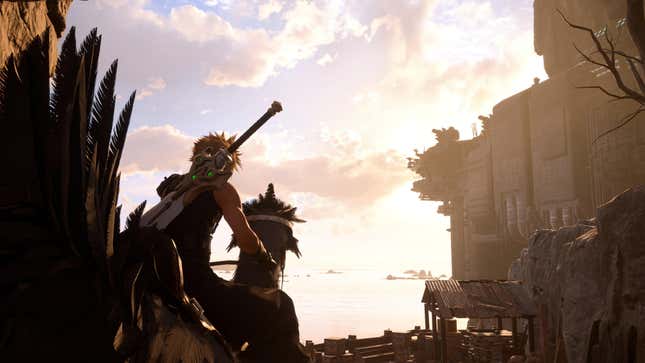
Though it’s got those familiar open-world vibes, the segmented world sections do help the world feel more digestible. They offer a variety of expansive aesthetics: lush trees and rolling green hills, sunbaked shores with jagged cliffs, a rich leafy jungle with giant mushrooms your chocobo can bounce on, and more. Rebirth offers that nostalgic feeling of traversing a whole world across your journey. It’s something that FF7 and other classic Final Fantasy games used to do more often. And it’s proof that it can be done in 2024. Future Final Fantasy installments ought to take note of this.
But what of the main story? The scripted sequences that take you through the trauma of a planet and its people?
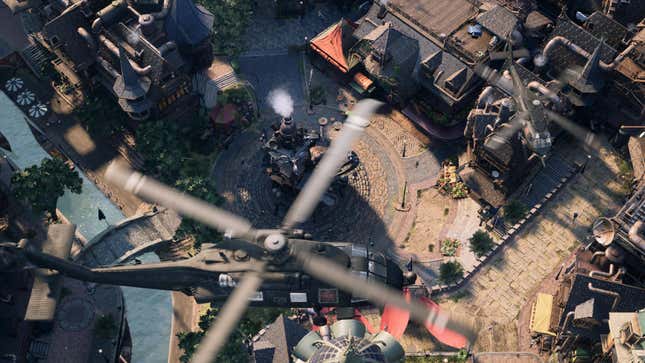
A beautiful story…that might test your patience
Rebirth alters key story beats, characters, lore, and locations to such a degree that they take on a very different meaning and tone from the original. Some of these changes work well. For example, Shinra maintains a more active interest in pursuing and finding Cloud and the gang than in the original FF7 because, you know, Rebirth begins just days after our little found family shot up Shinra’s headquarters at the end of Remake. Changes like this add narrative cohesion to the world and characters that isn’t always present in the 1997 game.
Pre-order Final Fantasy VII Rebirth: Amazon | Best Buy | Target
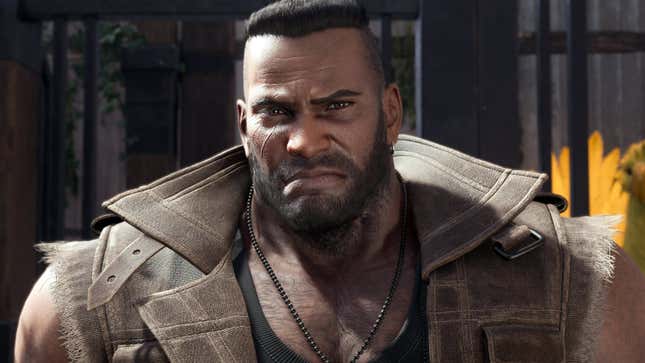
On the other hand, a sequence that’s a mere three rooms, an item or two, and a dialogue exchange in the original FF7 is now a multi-part quest with at least two boss battles and environmental exploration tasks. Other similarly expanded areas are often filled with unskippable mini-games that can be either fun or frustrating. All of this culminates in a sense that Rebirth doesn’t know when to give players a breather. When you arrive at scripted moments that are about having fun, playing some cards or carnival-esque mini-games, you’ve already been locked into so many mini-game-esque moments that you’re likely to find yourself very, very tired. This can be mitigated by taking your time through the game (please do), but it will still be a trial at times, especially as the game continues toward its lengthy conclusion.
At its core, Rebirth is a heavy narrative experience. The story is told through many lengthy scenes and shifts in perspective, and the ending might be difficult to digest on the first run—if not as a result of a confusing intersection of multiple different plot threads and characters, then certainly as a result of attention fatigue from needing to sit through all of it. And when you toss in changes to such a deeply beloved narrative, Rebirth is full of flammable materials waiting for the fires of the internet.
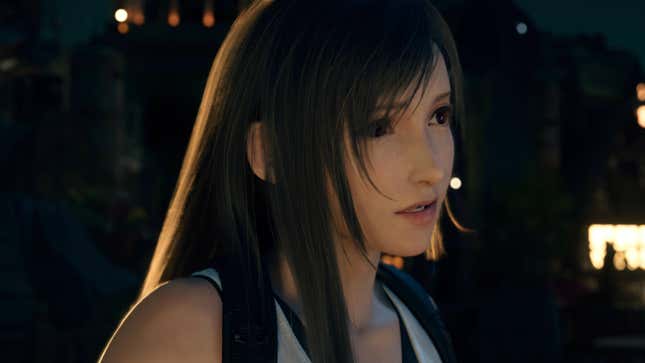
That said, I enjoyed the tender emotional moments between characters. On the whole, this is a compelling, dreamy reinterpretation of a narrative I’ve loved for decades. I was brought to tears regularly, and lovingly so. Cloud in particular has more nuanced emotional contours, especially as he begins to see his own harrowing vulnerabilities. And the overall story’s conclusion remains something I am still rattling around in my head. (In a good way!)
Just how many friggin’ mini-games did they make?
Rebirth has a lot of mini-games. There’s a deck-building card game, multiple combat strategy simulators, a handful of activities involving chocobos, a game where you’re chasing moogles, and more. Rebirth is the Sabrina The Teenage Witch pancake meme of mini-games. Many are fun! But over the course of the game, I couldn’t help but feel their overbearing presence was sometimes displacing a certain natural charm present in the original.

Red XIII has a mini-game in Rebirth, for example, that involves him kicking around a soccer ball. It’s a reference to a cute moment in the original game where Red lounges in the shade of a building in Costa Del Sol passing a soccer ball back and forth with some kids. You can enter into this “game” to be a horrible person in the original. It takes up all of a few humorous seconds, but it otherwise adds some character to the original in passing moments.
Rebirth doesn’t have too many spontaneous moments like this. Instead, the game often feels burdened with a need to gamify everything. Many of these mini-games are fun, but they’re just a little too omnipresent and mandatory to be considered a side activity.
Thrilling action combat with new layers of strategy
Rebirth’s combat is a fusion of real-time decision making and menu-selected actions for stronger attacks, buffs to your allies, and debuffs to your opponents. Everything builds up to a stagger meter that renders an enemy helpless once filled up. It’s built upon the system in Remake, and adds a new component this time: Synergy Abilities.
Synergy Abilities are combined attacks between two characters to do damage and/or impart some kind of buff to the party. I enjoyed looking at those moves to try and plan a way out to victory. Does it make more sense to give Tifa and Aerith unlimited MP because they have the necessary elemental spells to Stagger an enemy even faster? Or should I use the other one to juice Cloud and Aerith’s Limit Break gauge to deal extra damage when the enemy is Staggered? This decision making was a lot of fun when the heat of battle was pressing down around me.
I’d come back from each brawl learning something new about how Rebirth’s combat works, which in turn inspired me to reevaluate how I was distributing my materia—magical orbs that grant a variety of combat actions and buffs—across the characters I was using most often. And I’m really excited about continuing combat challenges and replaying old areas with greater mastery of this system. If only I could play it at a reliable 60 frames-per-second without a substantial drop in visual quality.
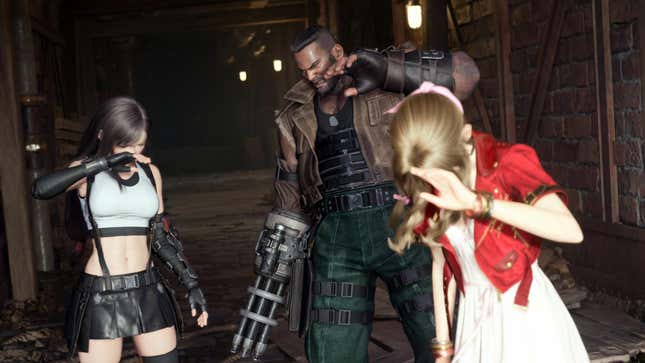
Oh, right, the technical issues
I spent the vast majority of my 90-hour playthrough of Rebirth in “Graphics” mode. This prioritized visual fidelity at the cost of 60-frames-per-second. I’m not offended by 30-frames-per-second as much as some; visual sharpness and clarity are more valuable to me. But damn, every time I switched over to “Performance” mode—which requires going three menu layers deep to swap—the reactivity of characters and menu systems made me wonder if I was doing the right thing. I would’ve liked some kind of hybrid mode that gave me greater frames at the cost of some blurriness when characters are zooming about the place. On top of some texture pop-in and a handful of bland textures here and there, Rebirth often looks stunning…except when it doesn’t.
And I would be remiss if I didn’t warn you about the audio in this game. Good heavens. I love this soundtrack with all of my heart, but the game’s audio has some serious mixing issues. During many optional battles for Chadley, the music will overlap with both party banter and NPC dialogue coming out of the DualSense, resulting in a chaotic stew of noise. After nearly 100 hours, I’m still making frequent adjustments to music, sound effects, and voice levels to try and find a good balance.
That said, the technical issues and wonkiness really didn’t stop me from emotionally investing myself in this game. Sure, some narrative changes are weird, but I gave this game and these characters my attention and my heart, and I was rewarded for it with a globe-spanning RPG with a depth of emotion, activity, and characters I love.
In the 1997 version of FF7, characters talk to one another through text (that was hastily translated and largely condensed in the English version); Cloud’s blocky polygonal model towers over tiny models of houses that signify towns and locations. We understand this not to be a direct representation of the world, but rather an abstraction. The original FF7’s presentation relies heavily on the imagination of the player to fill in the details and see the world as much bigger in our own minds than it necessarily is on the screen. The original FF7 is both an objective game that exists in the world, on three discs inserted into a PlayStation, and yet it’s an experience that many of us subjectively sunk ourselves into—especially those of us who played the original at a formative age. That experience is now adrift in the sea of memory, and has been for as much as 27 years for some.

Rebirth brought me back to my unique recollection of how the world looked and sounded in my mind. Yeah, the story is going in some different directions here, but somehow it feels as if Rebirth is acknowledging the FF7 that exists in my mind, and the ones that exist in all of our minds. I’ve come away from my playthrough realizing that the fates of certain characters—and what may or may not happen to them here in 2024—aren’t make-or-break moments for Rebirth. All of this already happened in 1997. Life and death are moments in time, contextualized by what precedes and follows. And Rebirth has a landmark title in the form of the original that came before, and a final entry in this trilogy to follow, one that has the challenge of taking its newfound themes and plot points into the future.
I found Final Fantasy VII Rebirth to be a very special game full of contemplative and entertaining moments. There are lines of dialogue I still think about during random moments in the day, scenes that I recall as I get out of bed, or go to sleep, make dinner, or take the train somewhere. Rebirth was an invitation to rethink and reconsider a game I’ve loved dearly for decades. It can be a very dark, sword-swinging, spell-casting extravaganza, but it can also be a tender, quiet space where one character says to another that they are emotionally searching for them in the stream of chaos that surrounds them. Rebirth’s narrative decisions surprised me for sure, but they didn’t repel me. Instead, they set me adrift in this magical liminal space that I’m still savoring—and trying to make sense of.
Rebirth is sure to be a more divisive and debated game than Remake was. But in this deep sea of an RPG, I was thrilled by the action and the tactics, brought to emotional highs and lows through its characters, and found myself with an even greater love of FF7, the original and this return, than I thought was possible.
Pre-order Final Fantasy VII Rebirth: Amazon | Best Buy | Target
.
